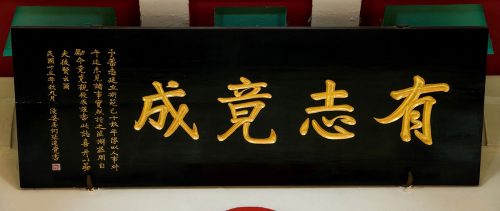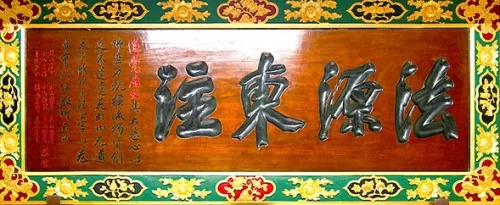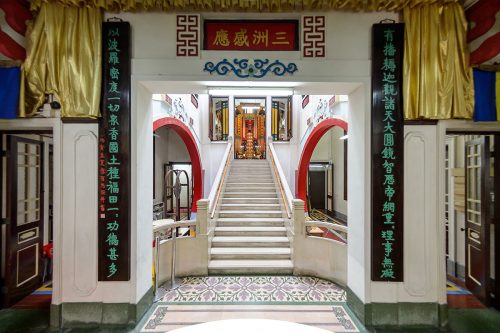Plaque

The plaque inscribed with the words “where there is a will, there is a way”, written by the founder Lady Clara, is currently hanging at the entrance of the Lin Kok Memorial Building. It commemorates her efforts over more than a decade in establishing Tung Lin Kok Yuen, culminating in its founding. The plaque serves to encourage students to be determined and persevering in pursuing their ambitions.

The Grand Buddha Hall is the main hall of a Buddhist temple where deities are enshrined and worshipped. Written by Sir Robert Ho Tung, the plaque “The Grand Buddha Hall” means the grand hall of Buddha Sakyamuni, who has profound wisdom and vanquish devils fearlessly.

The plaque inscribed with “Dharma Spring Transmit to the East” adorns the Grand Buddha Hall, which was generously gifted to Tung Lin Kok Yuen by nine esteemed monks including the Master Hsu Yun and Master Ai Ting. The plaque aimed to commemorate both the accomplishments of Tung Lin Kok Yuen and the endeavors of Lady Clara.

The red plaque above The Medicine Buddha Hall bears the inscription “A Solemn Net of Limitless Light.” It was bestowed by the internationally renowned sinologist Professor Jao Tsung-I (1917 – 2018) and is derived from the “Second Great Vow of the Medicine Buddha” found in the Sutra of the Medicine Buddha. The term “solemn” represents the luminosity of wisdom, while “net” symbolizes Indra’s net, associated with Śakra, signifying the boundless and infinite brilliance of the Buddha’s wisdom.

Tung Lin Kok Yuen was first designated as a Grade I historic building as early as 2009. In October 2017, It was formally listed as a Declared Monument in Hong Kong.
Couplet

The couplet is carved on the two side of the main entrance. It means that when the bright light (of Buddha-Dharma) sheds on the East, it dispels all worry and anxiety. All beings are led by the lotus flowers to the Pure Land in the West.

In front of the Grand Buddha Hall is a couplet written by Kang You Wei (1858 – 1927), a political philosopher, and educator in contemporary China. The couplet means that kind-hearted youths practice the teachings of Buddha to reach Enlightenment. The six virtues consist of generosity, morality, patience, perseverance, meditation, and wisdom. The perfections of these virtues will ferry one beyond the sea of immortality to nirvana.

The first line of the cuoplet commends Lady Clara’s faith in the Three Jewels of Buddhism. She invited masters to disseminate Buddhist teachings which brings joy to the followers; the second line suggests transmission of the Dharma from Lumbini (the brithplace of Buddha) to Tung Lin Kok Yuen, with many followers support the Dharma. The couplet was jointly composed by nine eminent monks: Venerable Hsu Yun of Nanhua Monastery, Venerable Ruo Shun of Qixia Monastery, etc. It was written by Venerable Shuo Pei.
Others

The dharma bell and bronze dharma drum, located on the sides of the Grand Buddha Hall, have a long history. The bronze bell was donated by Sir Robert Ho Tung and Lady Clara, while the bell’s surface is engraved with the Great Compassion Mantra, handwritten by Master Ai Ting.
In general, in Buddhist temples, the drum and bell are commonly placed on the left and right sides of the front of the main hall, hence the term “left drum, right bell.”


